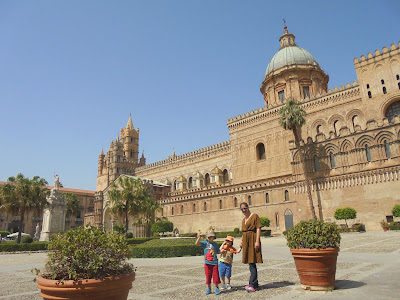Part of the draw of circumnavigating Sicily, was to explore
the different faces of this fascinating island. It was therefore essential that
we stopped by in the capital, largest city and melting pot of people’s past and
present – Palermo.
Everyone and his dog had warned us about the mad cap driving
in Palermo. We were not disappointed, with cars and mopeds winding in and out
of us on the road in to the centre, where we met narrow packed streets, honking
horns and, on one occasion, street urchins joyriding a moped right past us,
wheelie and all. It was a minor miracle that we arrived unscathed and found
some where to park. That somewhere was the tightest space I have ever parked in
on a dodgy looking back street, but, fortunately, a shop teller opposite
laughed at how long it took me to park and promised to watch the motor for us.
FOR RICHER FOR POORER
Palermo is not a rich city, but it contains many treasures.
Walking towards the historic centre through high, narrow, dirty alleys, it
immediately reminded me of umpteen Latin American cities. Semi-grand buildings
that had seen better days. Washing hanging out the windows between damp walls
and chipped stucco. Street noises and kids playing football. The hot smell of
pollution.
That may sound like a negative description, but for me it
was immediately alluring. From experience, these kinds of places are full of
interest, excitement and passion.
The comparison to Latin America is not just coincidence. Spaniards
ruled Sicily on and off for centuries, right down to when Palermo was a twin
capital of the Kingdom of the Two Sicilies (along with Naples). The influence
can be seen in the density of imposing ornate baroque churches. The most impressive sites are though of
older stock and this is where unique riches lie.
NORMAN PHENOMENA
It may come as a surprise that at almost exactly the same
time (well, OK, two years later) as a famous Norman by the name of William was
invading England, another Norman, named Roger, was invading Sicily. His dynasty
reached heights of sophistication rarely touched in medieval Europe.
A driver of this cultural blossoming, was the broad variety
of different cultures in situ in Sicily. Amongst others, there were Arabs,
Byzantine Greeks and, of course, the Normans themselves. Against the tide of an
age, the Norman kings embraced these different cultures with open mind, drawing
on the talents of each culture in terms of learning, philosophy
and architecture.
This can be seen in the almost Python’esque named "Book of
Roger" (check it out). For its time, a world map of unparalleled accuracy and beauty, created through
the patronage of King Roger and the brilliance of Al-Idrisi, an Arab. This was a product of one of the great courts of medieval Europe. A cultural flourish built on familiar Norman military prominence.
The architectural legacy is arguably even more impressive. As a first port of call, we visited the Norman Cathedral.
From the outside, it is an imposing and fascinating building. Combining
Byzantine Domes, Gothic buttresses and touches of Moorish decoration.
Unfortunately the inside is less interesting, with a later make-over which
masks much of the original style, but down in the crypt the original Norman remains.
After that, we visited the most famous site in the city.
Situated in the Palazzo Reale, which is itself no slouch in terms of interest
and architecture, is the Cappella Palatina (the Palatine Chapel). This place is
a wonder of the world.
At its heart it is a Byzantine church, with glittering
mosaics beyond any I have seen. This is then enhanced with delicate Norman
stone carving and simply beautiful Arabic wood carving. It is both surprising
and inspiring at every turn. I was spellbound and had to be dragged away in the
interest of stopping the kids climbing the walls.
Getting on for 900 years after it was commissioned by Roger
II, the Cappella Palatina is testament to the enlightenment of Norman Sicily and the enduring benefits of reaching out to and fusing with cultures beyond our own.
INTEREST AT EVERY
TURN
We spent the rest of the day pushing the pram around street
after back street, discovering new sights sounds and smells (not all pleasant)
at each turn. It was great to just get a little lost in the city, stumbling from dilapidated area to grand area and back again, and right through two bustling markets.
The first was for food of every description, the second for
cloth and clothes. The kids loved this bit, meandering in and out of different
stalls and getting a first grip on capitalism (finite funds
in their hands but seemingly infinite amount of things to spend it on).
We were also pleased to discover that Palermo does gelato as
good as any Italian city (as far as I can tell) and devoured the ice cream in
the shadow of what we discovered was an old mosque. Palermo really is a city full of surprises.
Out on our feet with the day at its end, we made it back to our protected car. The smiling shop teller wished us well and gifted the children some sweets. A nice end to a great day in the city. I got a taste of it and I want more, perhaps in the form of Palermo's Nuttier sister... Next year Napoli?







No comments:
Post a Comment